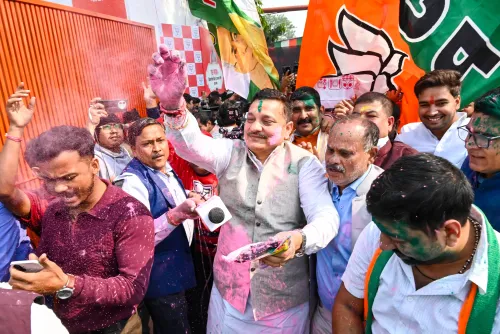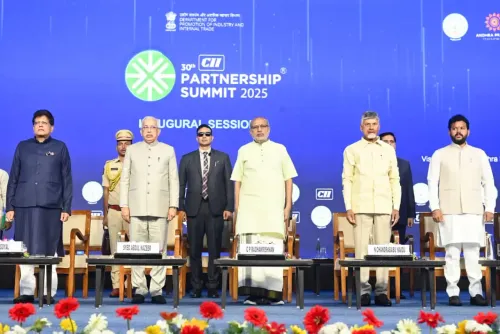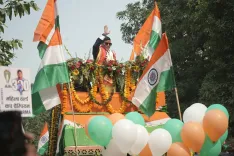How did Congress become the anchor that sank the Mahagathbandhan in Bihar?

Synopsis
Key Takeaways
- NDA's victory highlights the importance of effective coalition strategies.
- High voter turnout indicates strong engagement among the electorate.
- Congress's poor performance significantly impacted the Mahagathbandhan's overall results.
- Internal conflicts within the opposition weakened their campaign.
- The need for a unified approach in future elections is crucial for success.
New Delhi, Nov 14 (NationPress) In a decisive electoral outcome that solidifies the National Democratic Alliance's firm hold on Bihar, the ruling coalition achieved a remarkable victory, surpassing the majority threshold of 122.
Steered by Chief Minister Nitish Kumar's Janata Dal (United), the NDA's count was significantly enhanced by the Bharatiya Janata Party's impressive performance.
The voter turnout escalated to 67.14 percent, an increase of nearly 10 percentage points from 2020, indicating vigorous engagement amidst intense campaigning.
In stark contrast, the Opposition coalition, the Mahagathbandhan, which includes the Rashtriya Janata Dal (RJD), Congress, and Left parties, faced a devastating defeat.
The RJD, the backbone of the alliance, barely managed to secure less than 40 seats, while both Congress and the Communist Party of India (Marxist-Leninist) Liberation suffered significant losses.
The NDA's 47.2 percent share of the vote eclipsed the Mahagathbandhan's stagnant 37.3 percent, a slight increase from 37.23 percent in 2020, illustrating how vote efficiency and consolidation propelled the incumbents to triumph while fragmenting the Opposition's support.
This analysis explores the intricate dynamics behind the Mahagathbandhan's electoral collapse, drawing from data provided by the Election Commission of India, alliance strategies, and expert evaluations.
The defeat can be attributed to a detrimental combination of internal weaknesses, strategic missteps, and the NDA's adept counter-mobilization, which rendered anti-incumbency sentiments ineffective.
The Mahagathbandhan's unity deteriorated, burdened by its weakest link, Congress, whose poor performance diminished the alliance's overall momentum.
Contesting 61 seats, Congress managed to lead in only four, marking a dramatic 79 percent drop from 19 in 2020, with its vote share plummeting to around eight percent from 9.48 percent. This underperformance adversely affected allies like the RJD, which saw its seats cut in half from 75 to 31 despite achieving a 23 percent vote share, the highest among individual parties.
Internal disputes over seat allocations resulted in friendly contests in 11 constituencies, draining resources and voter clarity.
Rahul Gandhi's reported discontent with the seat-sharing arrangement kept him off the campaign trail for nearly two months following his September Voter Adhikar Yatra, weakening the alliance's vigorous push.
Key figures within Congress stumbled, with State party Chief Rajesh Ram losing by 3,721 votes and Congress Legislature Party leader Shakeel Ahmed Khan by 18,816. This highlighted a collapse in organizational strength, rendering Congress a liability that struggled to counter the BJP's narratives regarding vote theft accusations.
This vulnerability amplified the Mahagathbandhan's numerical disadvantage, as Congress's focus on Economically Backward Classes (EBC) alienated upper-caste constituents without securing new votes.
The Mahagathbandhan's aspirations of exploiting anti-NDA sentiment evaporated as splinter votes weakened its base.
Prashant Kishor's Jan Suraaj Party, making its debut with a 3.5 percent vote share, failed to secure any seats but siphoned off 2.8 points from the Mahagathbandhan's total by appealing to urban youth and migrants dissatisfied with the current job landscape.
Similarly, the All India Majlis-e-Ittehadul Muslimeen (AIMIM) fragmented Muslim votes in Seemanchal, where the Mahagathbandhan only managed to win in eight to ten out of 24 seats, a decline from stronger performances in 2020.
The Mahagathbandhan's vote share remained stagnant at 37.3 percent despite absorbing smaller allies like the Vikassheel Insaan Party for Mallah and EBC outreach, which failed to secure any seats from ten contests.
This fragmentation stood in contrast to the NDA's effective strategy, where the Effective Number of Parties fell to 2.65, transforming a 10-point vote lead into an additional 151 seats compared to the Mahagathbandhan.
In Shahabad, a former Mahagathbandhan stronghold with 20 out of 22 seats, the presence of Jan Suraaj helped the NDA flip to leads in 10 to 12 seats, demonstrating how new alternatives attracted undecided voters without benefiting the Opposition.
As Jan Suraaj Spokesperson Pavan K Varma acknowledged, their failure to earn trust was due to lacking grassroots connections, but the collateral damage to the Mahagathbandhan was significant.
Bihar's caste dynamics, previously the Mahagathbandhan's strength through the RJD's Yadav-Muslim coalition, were outmaneuvered by the NDA's broad social engineering.
The Mahagathbandhan's diverse mix of Yadavs at 14 percent and Muslims at 17.7 percent could not compete with the NDA's diverse coalition, which included a BJP upper-caste stronghold of 22 percent of the population, JD(U)'s EBC and MahaDalit surge with a four percent increase to 19 percent vote share, and LJP(RV)'s five to six percent Dalit and Paswan consolidation.
Voter turnout favored females by nine points over males, benefiting Nitish Kumar's 20-year goodwill stemming from initiatives like the Mukhyamantri Mahila Rozgar Yojana offering 10,000-rupee grants and Jeevika self-help groups.
Elderly women in Jehanabad cited ration and dignity as loyalty drivers, assisting the NDA in over 50 seats in Mithilanchal-Kosi.
Despite the Mahagathbandhan's core base, the NDA fielded four successful Muslim candidates, including JD(U)'s Shagufta Azim in Araria, leading in 10 to 12 Seemanchal seats, a significant shift from zero Muslim MLAs in the previous assembly.
The Mahagathbandhan's caste mobilization efforts did not yield results, as smaller inclusions like the Indian Inclusive Party for Tanti-Paan castes brought no rewards.
Tejashwi Yadav's 85 rallies focused on youth unemployment, but the Mahagathbandhan's alarms over electoral roll revisions and Nitish's inconsistencies fell flat against NDA's 84 Nitish-led development meetings.
Rahul Gandhi's outreach in the Muslim belt of Seemanchal failed, as the region shifted in favor of the NDA.
Tejashwi's prediction of winning 160 seats crumbled to leads of under 50, diminishing credibility amid the NDA's welfare narrative regarding housing and food rations.
Analysts attribute Nitish's unwavering ability to unite non-Yadav OBCs, constituting 35 percent of the electorate, while the Mahagathbandhan's defensive strategy overlooked aspirational shifts, resulting in losses in Magadh where the NDA secured 30 to 35 seats and in Angika with 20 to 23.
The Mahagathbandhan's significant decline from 110 seats in 2020 to 39 indicates a deeper malaise, with Congress's diminishing relevance and fragmentation threatening future national aspirations.
For the NDA, this outcome affirms Nitish's enduring strategy, although Jan Suraaj's 3.5 percent points to potential urban unrest brewing.
As Bihar looks toward 2029, the Opposition must reflect: rebuild alliances without the baggage, create ambitious visions, and reclaim the welfare-caste narrative.
Until then, Nitish Kumar's third term solidifies Bihar's NDA era.









